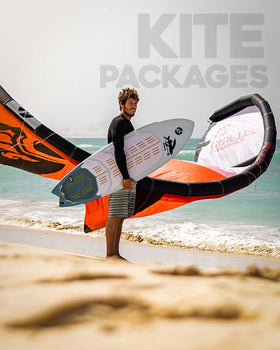
Harness Bars Compared
It seems like there are a ton of different kinds of harness spreader bars with different features. Kiteboarding certainly has come a long way from the old days when all spreader bars were pretty much the same. Now, you can choose from simple old school bars to bars that easily clip on and off to bars with short leash attachments to bars with a hook to bars with a rope to bars that are completely unique to bars with multiple attachment points and bars that only have one attachment on each end. Let's take a look at some features and what they can do for you.
By far the most common type of harness bar is the hook bar. This is pretty much the old school bar. It's simple and effective. Hook in the chicken loop, insert the chicken finger, and there it is. The hook isn't going anywhere any time soon. Most kiters will find this to be the most useful of the different options.
In recent years, as surf kiting has become all the rage, the rope slider bars have become popular. The purpose of the rope slider is to give you more freedom of movement when riding waves. The Chicken loop attaches to a ring that slides freely from side to side along the rope as you maneuver on the wave. If you are into wave kiting, you should definitely consider going to a rope slider. Ride Engine, Mystic, and Liquid Force all have rope slider bars in their lineups. ION has the best of both worlds with their hook and rope spreader bar.

Originally, the harness bar only had one attachment on each end for the webbing. While this does do the trick, newer bars with multiple attachment points allow you to get a better fit, are more comfortable and help keep the bar and harness from riding up your chest. Some also have a slot in the middle and a separate adjustable strap that cinches down to do an even better job of holding the spreader bar down. Mystic, Ion, and Neil Pryde have multiple attachment points to keep the harness spreader bar from riding up.

In the old days, you had to feed the webbing through the attachment slots every time you put your harness on. Now, things have gotten a lot easier. Some bars have mechanical release while others have some sort of hook and loop closure, so you don't have to adjust the straps every time. Neil Pryde, Mystic, Ion, and Ride Engine all have some version of this.

Back in the day, we all attached our long leashes to the back of the harness. Now, we're a bit smarter. Bad things can happen even after using the safety release. Sometimes the emergency release doesn't work as when the center line wraps around the bar preventing the bar from traveling away from you. When this happens, the kite may begin doing the "death loop" requiring you to release from the safety leash which can be very hard to do if the release is behind your back! A leash attachment in the front will be much easier to reach should this happen to you. The fact of the matter is, unless you are doing handle pass tricks, there is no legitimate reason to use a long leash attached to the back of your harness. It is far safer to attach it to the front using a short leash and safer still to use a spreader bar with a dedicated leash attachment point vs attaching it to the spreader bar hook as this can get in the way of the proper function of the release. Neil Pryde and Mystic have a dedicated leash attachment on the front.

All spreader bars used to be made of stainless steel. Yeah, it did the job but now some companies are using some lighter weight composites. Neil Pryde and ION have lightweight composite spreader bars that significantly reduces the weight of your harness.

All modern spreader bars also have a spreader bar pad. This makes the harness significantly more comfortable as it protects you from the spreader bar digging into your chest.




Leave a comment